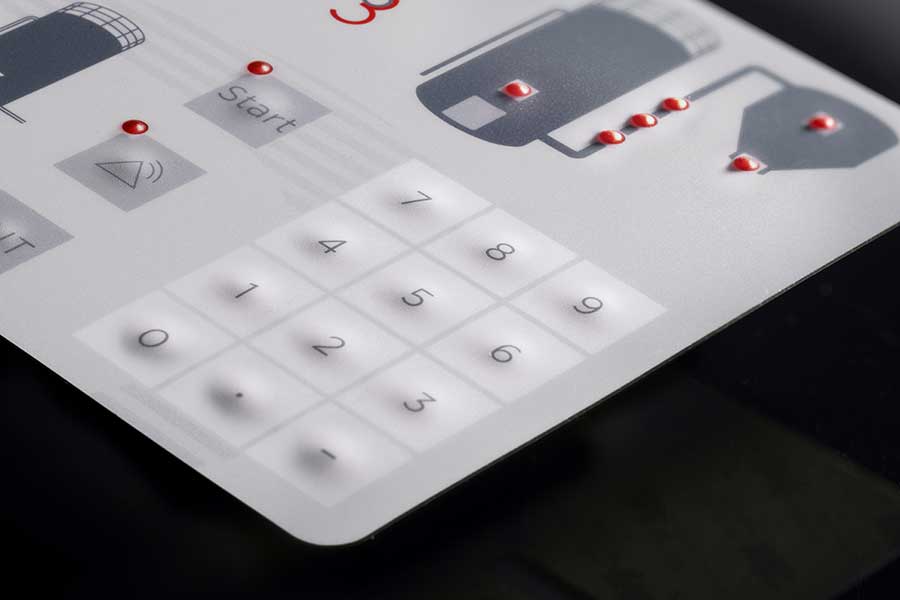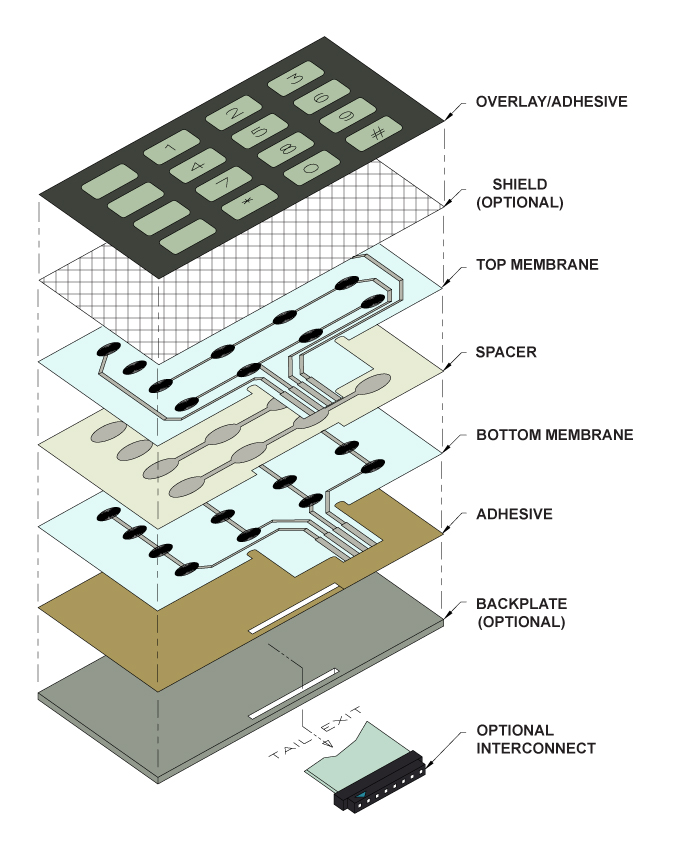Everything About Membrane Switch Over: Comprehending Its Style and Functionality
When you think regarding the control user interfaces in modern tools, membrane layer switches commonly come to mind. Let's discover what collections membrane layer changes apart from various other control systems.
What Are Membrane Layer Switches?

Their seamless nature makes them easy to clean and resistant to dirt and dampness, an essential function in numerous settings. Membrane switches can also be customized relating to form, size, and graphics, allowing producers to create unique user interfaces customized to details items. And also, they're lightweight and slim, which helps in reducing the total mass of gadgets. On the whole, membrane switches play a significant role in enhancing customer experience across a wide selection of applications.
Exactly How Membrane Switches Work
When you press a key on a membrane switch, it turns on a straightforward yet reliable device. The top layer, often made of flexible product, pushes down onto a conductive layer beneath it. This activity bridges the gap in between conductive traces, completing an electric circuit. As quickly as the circuit closes, it sends a signal to the gadget's controller, which translates your input.
You'll notice that the responsive responses differs based on the switch design, using either a soft click or an extra pronounced response. Once you launch the secret, the membrane returns to its initial position, reopening the circuit and quiting the signal. This process happens practically instantaneously, making sure a responsive customer experience.
Membrane switches are prominent as a result of their toughness and resistance to dirt and moisture, making them perfect for different applications, from household home appliances to clinical tools. Recognizing this operation helps you value their widespread usage.
Key Components of Membrane Switches
Understanding the vital parts of membrane layer buttons is basic for grasping their performance and style. At the core, you'll locate the graphic overlay, which provides the aesthetic user interface for customers. Beneath that, there's a spacer layer that divides the circuit layers, making sure that they don't make contact up until pressed. The circuit layer is where the magic takes place; it contains conductive traces that complete the circuit when you press the switch. One more necessary element is the sticky support, permitting the button to comply with surfaces safely. The protective layer shields versus environmental elements and put on, expanding the button's lifespan. Each component plays a significant function in ensuring reputable efficiency and user interaction. By understanding these parts, you'll gain insight right into how membrane changes run and their relevance in different applications.
Products Made Use Of in Membrane Change Layout
The performance and toughness of membrane changes heavily rely on the products utilized in their layout. You commonly run into polyester and polycarbonate as key substratums due to their exceptional toughness and flexibility. These materials withstand scratches and chemicals, making them optimal for requiring environments.
The conductive layers typically use silver or carbon, chosen for their integrity and conductivity. membrane switch manufacturer. Silver gives remarkable efficiency, while carbon is a cost-efficient option. For the overlay, you could think about a matte or shiny surface, depending on your visual needs and customer experience
Adhesives play an important duty also; they bond layers securely and guarantee long life. Make sure to pick adhesives that endure ecological aspects like temperature and moisture. Lastly, don't forget the significance of an excellent printing method for graphics, as Going Here it boosts both performance and visual charm. Selecting the appropriate materials will guarantee your membrane layer button stands the examination of time.
Design Considerations for Membrane Switches
While developing membrane layer switches, it's important to take into account different elements that affect their performance and user experience. Beginning by focusing on the format and switch dimension; make certain they're instinctive and very easy to navigate.
Confirm your layout suits ecological factors, like moisture or temperature variations, which could impact efficiency. By carefully considering these components, you'll produce a membrane switch that enhances functionality and complete satisfaction.
Applications of Membrane Layer Buttons
Membrane buttons are versatile components located in different applications, from industrial devices to consumer electronics. You'll see their impact in makers that require resilient interfaces and in gadgets that take advantage of sleek designs. Comprehending these applications aids you value the capability and usefulness of membrane layer switches in everyday technology.
Industrial Tools Usage
When you're aiming to boost the performance view of industrial devices, membrane layer buttons provide a reputable service that incorporates durability with user-friendly style. These switches are perfect for harsh environments, giving resistance to dust, wetness, and chemicals. You'll locate them in control panels for manufacturing devices, HVAC systems, and clinical gadgets, where precision and responsiveness are vital. Their reduced profile suggests they fit effortlessly into various equipment, conserving beneficial space while preserving simplicity of use. With personalized graphics and backlighting alternatives, you can create an user-friendly user interface for drivers, enhancing performance and security. Plus, their lengthy life-span reduces upkeep costs, making them a smart financial investment for your commercial applications. Accept membrane layer switches to improve your operations and boost general efficiency.
Consumer Electronic Devices Assimilation
In the domain of customer electronic devices, membrane switches play a vital duty in visit this web-site improving customer communication and tool performance. You'll find them in gadgets like microwaves, push-button controls, and gaming consoles, offering a seamless method to connect with innovation. Their smooth style permits for simple assimilation right into various items, making controls intuitive and user-friendly. With their capability to include graphics and backlighting, you can take pleasure in a contemporary aesthetic that matches the device's total look. Membrane buttons likewise ensure toughness and resistance to dust and dampness, prolonging the life expectancy of your electronic devices. By selecting membrane layer switches, you boost not simply the capability yet likewise the style of your devices, making day-to-day interactions smooth and satisfying.
Advantages and Downsides of Membrane Switches
While membrane layer buttons provide a range of benefits, they additionally come with some drawbacks that you ought to take into consideration. One substantial advantage is their small style, making them perfect for space-constrained applications. They're also cost-efficient, supplying a durable option with a low manufacturing cost. Furthermore, their seamless surface area is simple to tidy, enhancing health in settings like healthcare facilities.

Membrane switches can have a much shorter life-span contrasted to mechanical switches, particularly under hefty use. They can also be less tactile, which might affect customer comments during procedure. Balancing these pros and disadvantages will help you identify if membrane layer buttons are the ideal fit for your job.
Often Asked Inquiries
Exactly How Long Do Membrane Changes Usually Last?
Membrane switches generally last between 5 to ten years, relying on usage and environmental conditions. You'll intend to examine variables like wear, direct exposure to dampness, and temperature level fluctuations to gauge their long life successfully.
Can Membrane Switches Over Be Custom-made for Specific Styles?
Yes, you can tailor membrane switches to fit particular designs (membrane switch manufacturer). You'll have the flexibility to pick shades, shapes, and designs that match your project's requirements, ensuring they mix perfectly with your overall aesthetic
What Is the Price Variety for Membrane Layer Change Production?
The cost array for membrane switch manufacturing generally drops between $1 and $10 each, relying on factors like style intricacy, amount, and materials. You can obtain quotes from suppliers to find the most effective alternative.

Are Membrane Layer Switches Water Resistant or Immune?
Membrane switches can be developed to be waterproof or immune, relying on materials used and building and construction techniques. If you need them for damp atmospheres, ensure you specify those demands throughout the layout process.
How Do Membrane Layer Switches Compare to Conventional Switches?
Membrane layer buttons are usually thinner and much more flexible than traditional switches, supplying a smooth layout. They're frequently less complicated to clean up and integrate, but may not provide the responsive feedback you're made use of to with mechanical options.
Conclusion

Comments on “Many designers favor working with a proven membrane switch manufacturer for custom builds.”